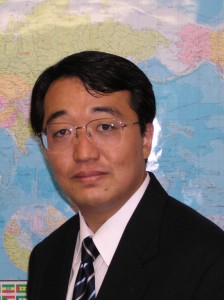緊張と統合:内村鑑三におけるキリスト教と日本の精神
このシリーズでは、私が1994年に執筆した統一神学大学院(Unification Theological Seminary)の神学課程修士論文(Divinity Thesis)を日英二か国語で掲載している。
2.アメリカの宣教師と日本のキリスト教徒の続き
外国による支配からの経済的・神学的独立は、日本のキリスト教徒達の当初からの強い願望であった。侍達は、キリスト教の倫理が近代日本の建設の助けになるであろうと信じてキリスト教に改宗したのであり、彼らは如何なる形においても西洋の支配を受け入れることを意図したわけではなかった。
国粋主義的な精神が国中に吹き荒れた時、世論はキリスト教が外国からの輸入品であることに対して非常に批判的になり、宣教師達は外国の手先として、改宗者は国籍を失った卑怯な非国民として攻撃された。この様な批判が、日本のキリスト教徒達をして以前にもまして西洋からの経済的・神学的独立を望ませるように仕向けたのである。
外国の宣教師達はこの運動に対して、彼らの神学的正統性の形而上学的・教義的な基礎を固めることによって応酬した。このような外国人達の保守主義的は反応は、宣教師達と日本の教会の指導者達との間に、深刻な緊張を生みだした。このようにして日本のキリスト教徒達は、自らの信仰と国家の双方に忠誠を示さなければならないという、困難な仕事に直面したのである。最終的には外国の宣教師達の権威と影響力は、より率直な日本人のキリスト教徒に比べて低下するようになった。その理由は、彼らの多くが通訳を通して働きかけなければならなかったことにある。
C.第三段階:無教会運動の出現
カルダローラは、「アメリカの宣教師達と日本の侍の出会いにおける、全般的な社会心理学的な力学を特徴付けるものは、双方が自らの文化的なアイデンティティーを保持することに没頭していたことにある」と論じている。その多くが苦しい適応の過程を通過している社会階層の出身である日本のキリスト教徒達は、キリスト教の倫理を吸収することによって彼らの精神伝統を復興させようと欲したのである。彼らはこの願いを三段階の過程を通過して果たした。
カルダローラは、この出会いの第一段階において日本人は「自己卑下の感情」を発達させたと描写する。彼らは自国が早急な近代化を必要としているということを悟るにおよんで、一時的な劣等コンプレックスを持つようになったのである。第二段階の特徴は、日本人の側における「自己再評価の感情」である。日本人は自国を近代化することに成功し始め、西洋人についてより多くのことを学ぶようになるにつれて、徐々に自己卑下の感情を克服し、時には自分達が西洋の挑戦者達よりも優れていると見るまでにさえなったのである。
カルダローラは、内村をもってキリスト教の日本における受容の過程は、「復興」段階とでもいうべき、第三の段階に到達したと結論する。この段階においては個人は、出会おうとしている二つの文化の中の適合可能な要素を選択し、統合させる自分の能力に充分な確信を持っている。すなわち、復興により個人は「日本人」であると同時に「キリスト教徒」である自分自身の、バランスの取れたイメージを確立することができるようになったのである。
II. American Missionaries and Japanese Christians (Cont.)
Financial and theological independence from foreign domination was a strong desire of Japanese Christians from the beginning. Samurai converted to Christianity in the belief that Christian principles could help in the establishment of a modern Japan; they did not mean to accept any form of western domination.
When the nationalistic spirit swept the country, the public opinion became highly critical of Christianity as a foreign import; missionaries were attacked as foreign agents, and converts as lackeys who had lost their national identity. This criticism made the Japanese Christians more eager than ever to seek financial and theological independence from the West.
The foreign missionaries counterattacked this movement by consolidating the metaphysical and dogmatic bases of their theological orthodoxy. This foreigners’ conservative reaction caused severe tensions between the missionaries and the Japanese church leaders. Japanese Christians thus had to face the difficult task of demonstrating their loyalty to both faith and country. Eventually the authority and influence of the foreign missionaries declined compared to the more outspoken Japanese Christians because many of them had to operate through translators.
C. Third Phase: The Emergence of the Non-Church Movement
Caldarola analyzes that, “the basic features that characterize the entire socio-psychological dynamics of the encounter between American missionaries and Japanese samurai is the preoccupation of both sides with preserving their cultural identities.” The Japanese Christians, most of them came from a social group undergoing painful adjustment, were eager to revitalize their spiritual tradition through the assimilation of Christian ethic. They achieved this desire through the process of three phases.
Caldarola describes the first phase of the encounter as the stage in which Japanese developed a “feeling of self-abasement.” The realization that their nation was in need of immediate modernization resulted in a temporary inferiority complex. The second phase of the encounter was characterized by a “feeling of self-revaluation” on the part of Japanese. As they began to succeed in their efforts to modernize their country and as they learned more about the westerners, they gradually outgrew their feeling of self-abasement even to the extent that at times they saw themselves as superior to the western challengers.
With Uchimura, Caldarola concludes, the acculturative process of Christianity in Japan reaches a third stage of development that may be regarded as the “revitalization” stage. In this stage the individual has enough confidence in his own capabilities to enable him to select and integrate those elements of the two contacting cultures which are compatible. In other words, revitalization enables the individual to achieve a balanced image of himself both as a “Japanese” and as a “Christian.”
(7)Caldarola, pp.35-37.
(8)Caldarola, p.40.
(9)Caldarola, p.40.
(10)Caldarola, p.40-49.
